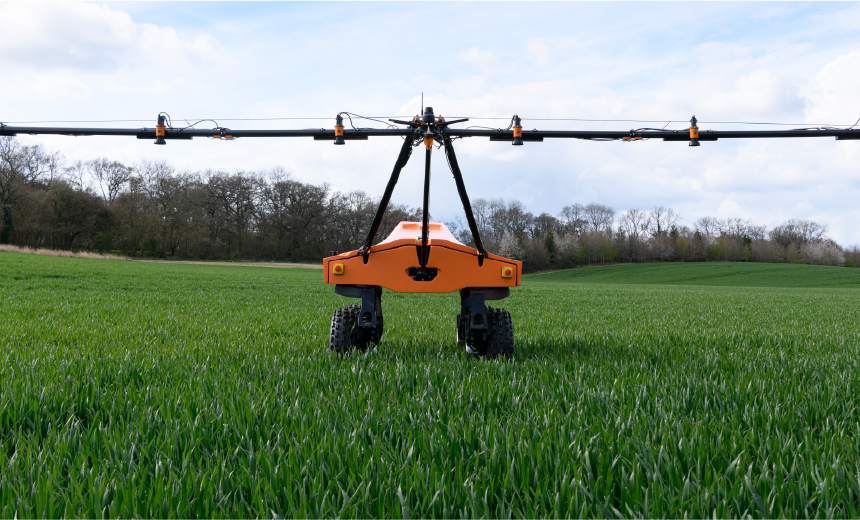Images of robots weeding fields or harvesting fruit and vegetables are no longer confined to science fiction movies – this has become reality on increasing numbers of farms worldwide, transforming the future of agriculture.
It all began at Harper Adams University in the UK, where academic staff set up an experimental Hands Free Hectare scheme. An innovative idea, it was the first time that anyone had tried to grow, tend and harvest crops purely with robots. By 2019, the project had proved so successful that Harper Adams developed a totally robotic Hands Free Farm. Professor Lowenberg-DeBoer of Harper Adams University commented, “This is the only place on earth – certainly within the public sector – where you can get information about a whole cycle for comparing results…..particularly with autonomous equipment. Arable crop production using autonomous equipment is both technically and economically feasible.”
>>>READ: How High Prices are Spurring Farmers to Adopt Eco-Friendly Fertilizers
Other projects soon began appearing elsewhere, in Australia for example, the Charles Sturt University is working with the Food Agility Co-Operative to explore farming options using drones, robot tractors, harvesters and pickers. In addition, smart sensors are being used to monitor carbon emissions released into the air when working on the farm.
Technological companies and agricultural manufacturers have been quick to respond to such innovative research. With fewer people working on the land, and increasing demand for higher levels of quality food production, farmers are finding that using robots is making their tasks easier.
One of the biggest names in tractor production, John Deere, has already begun moving into robotic machines. In 2021, it purchased Bear Flag Robotics, a Silicon Valley start up, which retrofits tractors with sensors, computers and control systems. Similar companies are already active elsewhere in the world, such as Israeli company Blue White Robotics, which is retrofitting farming systems with both hardware and software suitable for any type of tractor, from a John Deere to a Kubota. Alon Ascher of Blue White says that the kit “knows how to handle the different implements that tractors are using for example spraying, mowing, disking, dusting – all the different tasks that the normal drive would do.”
John Deere has indicated that ultimately it is aiming for tractor cabs possessing a totally new operating concept utilising artificial intelligence, complete with joystick control, touchscreen displays and networking machine systems. The intention is to turn the cab into a ‘command centre for agricultural operations’, integrating ‘real-time weather data, individual pre-setting and job management procedures.’ Hands-free Auto Track satellite guidance enables harvesters to be steered while tractors can utilise built in cameras to apply plant protection products autonomously to crops.
It is not just large-scale arable farming that is proving attractive to AI and robotic concepts. Greenhouse production methods are increasingly utilising sensors and AI robots. In the UK, attention is focusing on ways in which small farms can utilise robot assistance. The Small Robot Company has launched Tom, a crop monitoring robot, which is capable of delivering the world’s first plant weeding and mapping with sub-millimetre resolution. Tom scans crops to detect weeds, then alerts a Dick robot to arrive to zap individual weeds using electrical lighting strikes rather than chemicals. These robots are already being used on UK farms such as those owned by the National Trust. Other pilot applications being introduced by the Small Robot Company include SlugBot, which uses hyper-spectral cameras to detect slugs active at night, before treating them biologically using microdoses of nematodes. The Small Robot Company has indicated that ultimately the Tom Robot will be able to gather a variety of data while working in the fields by using sensors to note individual birdsong and pollinators to assess soil health and biodiversity. An added advantage is that these robots are far more lightweight than a conventional tractor, thus improving soil health by reducing soil compaction.
>>>READ: Innovative Agriculture Just Got a $53 Million Boost
Using robotics on farms is also becoming more cost-effective than investing in conventional machinery. Seattle based, Carbon Robotics reported nearly selling its entire laser-armed weeding robot 2022 production stock within a through 2023. Carbon Robotics indicated that using their weeding technology could recover investment costs within 1.5-3 years, which could allow farming to become more profitable, especially for small scale businesses that combine farming with other activities like livestock, farm tourism, or off farm employment.
Above all, the arrival of robotics into farming practices is set to result in the provision of extremely accurate production data, reducing the need to apply herbicides on a large-scale basis, and monitoring environmental factors relating to climate change. As Sam Watson Jones from the Small Robot Company points out, “Robotics can already take billions of accurate measurements in each field. This will transform the way that farms are able to sequester and cycle carbon. The opportunity for agriculture to support the transition towards Net Zero is enormous.”
Angela Youngman is a long established freelance journalist and author based in the UK specialising in business, sustainability, travel, tourism, leisure, food & drink.
The views and opinions expressed are those of the author’s and do not necessarily reflect the official policy or position of C3.
